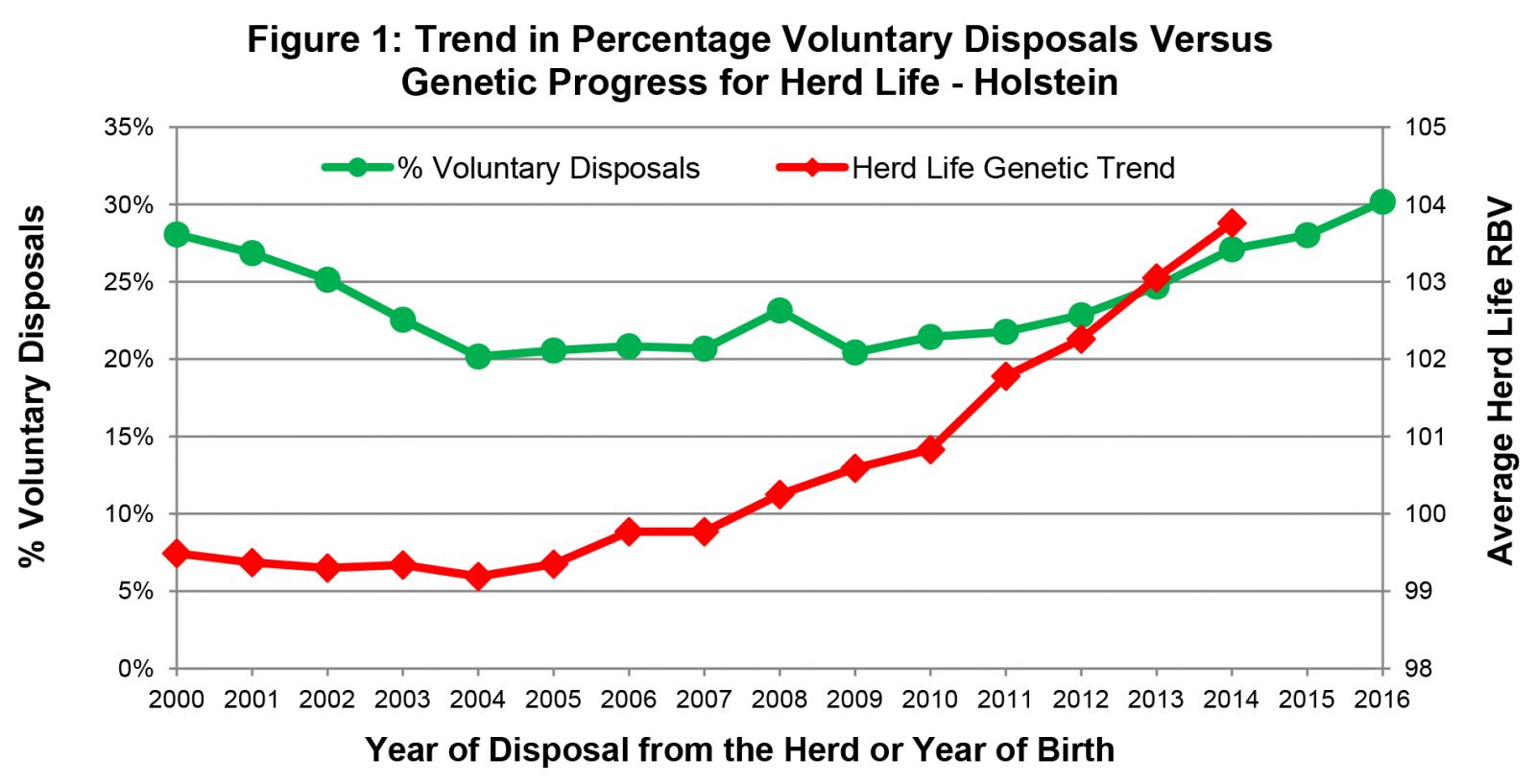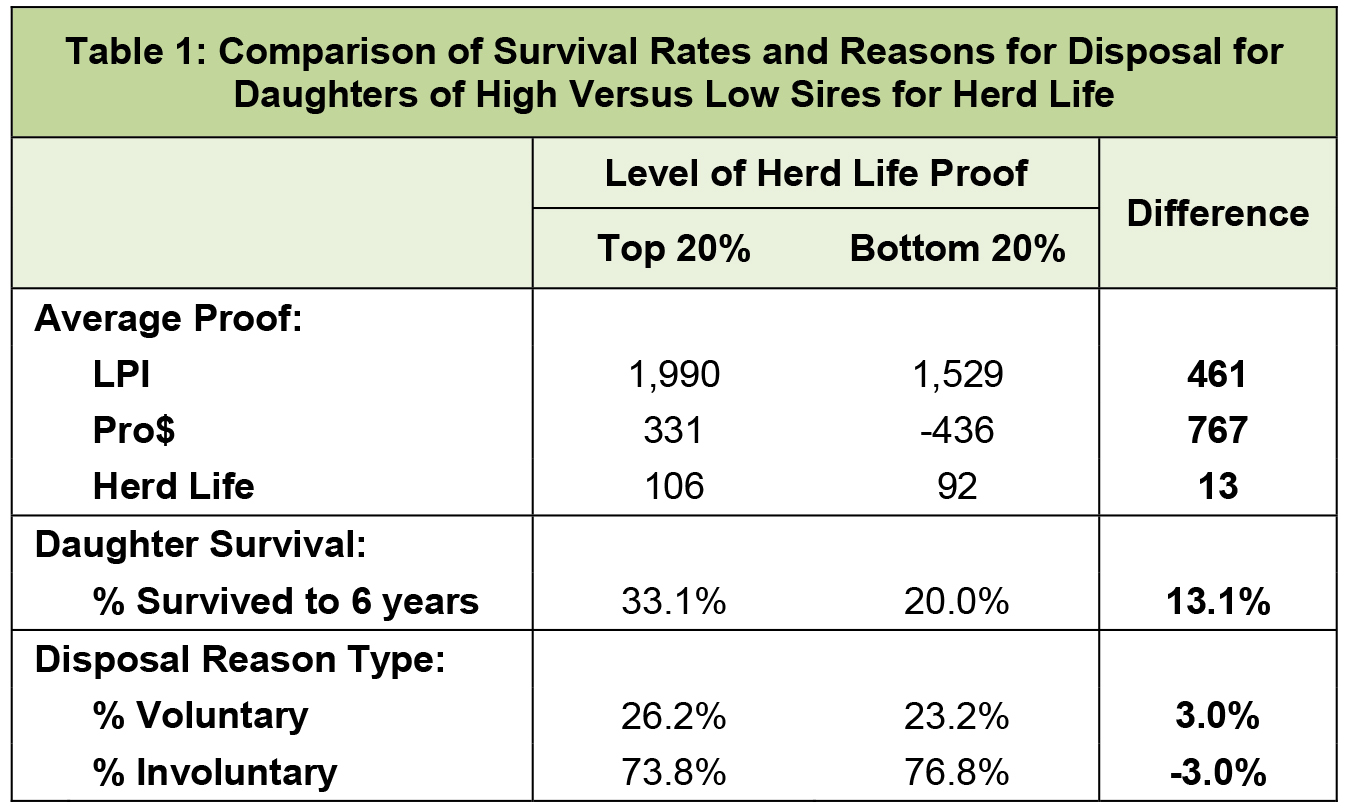By:
Lynsay Beavers
Brian Van Doormaal
The aim of Herd Life - Canada's genetic evaluation for longevity - is to give producers the choice when it comes to removing animals from their herd. In other words, the evaluation is designed to increase voluntary disposals, and as a result, decrease involuntary culling. Evidently, herd disposals are highly related to many non-genetic factors such as the market environment. Nonetheless, genetics does play an important role in longevity and due to its high economic importance, some emphasis on genetic selection to improve Herd Life is warranted.
The Challenge with Longevity
An underlying challenge with genetic selection for longevity is that it is only observed at the end of each cow's productive life, which is too late to be of practical value for evaluating their sire's genetic potential. This is especially true today with nearly 70% genomic young sire usage in Holsteins - bulls are primarily used long before there is survival data available on their daughters. As a result, known predictor traits of longevity are the primary source of information in a genomic sire's evaluation for Herd Life.
A second problem associated with longevity is that all measures are highly affected by herd management and other non-genetic factors. For example, in the Canadian supply-managed environment, the fastest way to increase or decrease herd production to meet quota or fill incentive days is by purchasing or removing cows. Clearly, in these situations the genetic potential of an animal doesn't change, warranting them to be removed or added to a herd. The decision is strictly based on management in order to quickly increase or decrease herd production.
Herd Life Evaluations
Published proofs for Herd Life are a combination of a predicted value based on proofs for various indicator traits associated with longevity (Indirect Herd Life) and evaluations based on actual daughter survival data through each of the first three lactations to fourth calving (Direct Herd Life). The indicator traits used in the Indirect Herd Life portion of the evaluation are based on traits that have shown to be useful indicators of survival from older bulls that have many daughters with actual survival information. Since bull proofs for Herd Life in Canada are designed to be independent of their daughter's production levels, only non-production traits are used for possible inclusion in the prediction of Indirect Herd Life.
Direct Herd Life evaluates survival through first lactation, second lactation and third lactation as separate but correlated measures of longevity. As a bull's daughters age, an increasing amount of information is gained for these direct measures of longevity. At any given time, a bull's Herd Life proof is a combination of his predicted value based on proofs for the indicator traits, plus his evaluation for each of the three measures of daughter survival.
Interpretation of Herd Life
To facilitate the interpretation of Herd Life evaluations, CDN provides measures of actual daughter survival by sire along with breed averages for comparison, as seen in the image below. Bulls that have daughters with survival data during certain periods will only display data for those periods. This is the case with the example bull whose oldest daughters, at this point, are in second lactation.

Herd Life and Voluntary Culling
As with all traits with a lower heritability, genomics has significantly increased the accuracy of Herd Life evaluations, therefore speeding up genetic progress for the trait. In 2004, Herd Life was included in the LPI formula due to the growing interest in this trait by producers. Since that time, there has been a steady increase in the genetic trend for Herd Life, as seen in Figure 1 based on cows with an official LPI born from 2000 to 2014.

As previously mentioned, the aim of genetic selection for Herd Life is to create dairy cows that have the genetic potential to remain in the herd until you, the herd owner, decide to voluntarily remove them. For this reason, it's interesting to compare genetic trends for Herd Life to the trend in the percentage of herd disposals that are voluntary.
Figure 1 shows the trend for the percentage of herd disposals that are voluntary (as opposed to involuntary) based on the year of each animal's removal from the herd. This trend lags behind the genetic trend by birth year since cows are generally removed from the herd as mature animals. In Figure 1, it can be noted that the upward genetic trend for Herd Life for animals born since 2004 seems to have translated into a subsequent increase in the percentage of cows that have left the herd for voluntary reasons, as a result of the producer's decision, instead of due to a reason associated with involuntary culling.
To further examine the relationship between Herd Life and voluntary disposals, actual daughter survival data to 6 years of age was analyzed for over 1,000 proven Holstein sires, which were divided into five groups (i.e.: quintiles) based on their Herd Life proof. Compared to the top 20% of sires for Herd Life, the bottom 20% of sires had 13% fewer daughters survive until 6 years of age (Table 1). Differences were also observed in the percentage of daughters removed from the herd for voluntary versus involuntary reasons. Cows sired by the top group for Herd Life experienced 3% more voluntary culling (and as a result, 3% less involuntary culling) than daughters of sires that ranked in the bottom 20% for Herd Life included in the study.

Despite the undeniable influence of management on herd disposal decisions, Herd Life evaluations do reflect the expected survival rates of each sire's daughters. Selection for Herd Life should put producers in the driver's seat more often, giving them the chance to make herd disposal decision themselves, as opposed to having the cow, one way or another, making those decisions for them.
Source:CDN